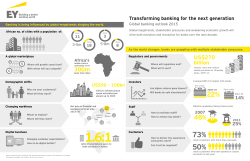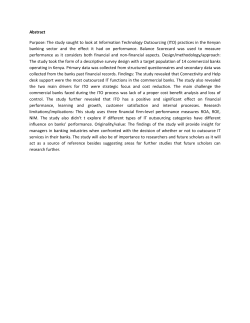
Recession looms for Brazil this year as credit woes continue to mount
NUS Risk Management Institute rmicri.org Recession looms for Brazil this year as credit woes continue to mount by Dexter Tan Last week, the central bank of Brazil announced that they will cease the USD swaps program in April, reducing support for the world’s worst performing currency. The BRL is expected to depreciate further against the greenback as the swaps are equivalent to short positions in the USD. In addition, Fed chairwoman Janet Yellen said on Friday that the Federal Reserve plans to raise interest rates later this year, a move likely to further strengthen the USD. A higher USD could affect the credit outlook for many Brazilian firms because of the adverse impact it would have on import dependent companies. The creditworthiness of Brazilian companies has been declining since July 2014. The RMI aggregate 1-year probability of default (PD) for Brazilian firms, which is a simple median of the PDs of 271 corporations, has increased from 20bps in July 2014 to 41bps on Mar 27, 2015, reflecting serious concerns for the economy. Brazil’s economic output barely grew in 2014 and the central bank predicts a recession this year. The Getulio Vargas Foundation said consumer confidence fell to a record low in March on the back of rising unemployment and lower disposable family incomes. Banks have set aside more provisions for bad loans as they prepare for loan portfolio losses in the petrochemicals, oil and gas industries. Consumer spending dropped to a 12 year low, affecting the credit profiles of retailers as inflation reached the highest level in nearly 10 years. Figure 1: RMI aggregate 1-year PD vs USDBRL. Source: Risk Management Institute, Bloomberg Amongst a sharp increase in electricity and fuel prices, Brazil’s soaring inflation is also fed by climbing food prices, which were driven by a severe drought in the southeastern part of Brazil. Megacity Sao Paulo is facing an acute water shortage as the rainy season between December and February did little to raise main reservoir levels. RMI 1-year PD for Cia de Saneamento Basico do Estado de Sao Paulo, Latin America’s largest public water company, has spiked over the recent months, rising to as high as over 50bps in Jan 2015. The company is trying to find new water supplies as the drought has nearly dried up the entire Cantareira reservoir. NUS Risk Management Institute rmicri.org As of Median DTD Median NI/TA ( %, RMI adjusted) Total market cap (USD bn) Brazil govt 3M rate (%) 6/30/2014 3.24 2.39 1035 10.90 9/30/2014 3.12 1.95 930 10.95 12/30/2014 2.55 1.80 791 12.30 1/30/2015 2.07 1.80 739 12.45 2/27/2015 2.12 12.75 2.20 751 Table 1: RMI credit related performance metrics and funding rates for Brazilian companies. Source: Risk Management Institute, Bloomberg As seen in Table 1, input variables in the RMI PD model illustrate weak credit metrics across the Brazilian corporate sector. A sharp decline in the RMI median distance-to-default (DTD) between Jun 2014 and Feb 2015 highlights increasing credit risk, with a lower DTD value indicating higher potential insolvency. The median net income to total assets ratio, a proxy for profitability, and the total market cap have also dropped during this period. Moreover, the funding costs of Brazilian corporations have risen considerably given that the central bank has lifted interest rates to a six-year high of 12.75% in early March. On Mar 26, Brazil’s monetary authority hinted that the benchmark Selic rate could head higher as inflationary expectations remain too high for the central bank’s comfort. At the center of all the operating headwinds facing Brazilian firms is the scandal at Petrobras, once the world’s fifth largest company. In Nov 2014, RMI highlighted the negative implications of the situation involving Petrobras. As more details about the scandal were uncovered, anti-corruption investigators have extended the probe to over 200 firms, thereby creating an uncertain outlook over the credit profiles of these firms. Moody’s claimed that Brazilian bank earnings would be hurt from Petrobras related exposures and lead to a tightening of credit conditions within the local banking system. Overall, the health of Brazilian firms is likely to get worse before it gets better. The country’s businesses are suffering from the austerity measures under the President’s initiative. The government said the reforms were necessary to cut the fiscal deficit but the tax increases and stricter rules for unemployment benefits have started to hurt the companies’ earnings abilities and credit profiles. Credit News Shipbuilder Rongsheng reports RMB 3.8bn in negative revenue Mar 31. Embattled shipbuilder China Rongsheng Heavy Industries reported RMB 3.8bn in negative revenue for last year, and a precarious balance sheet with RMB 18.2bn in borrowings immediately payable. Net losses amounted to RMB 7.8bn. Rongsheng said the negative top-line was due to a reversal of revenue of some RMB 4.5bn arising from cancelled contracts. (SCMP) Malaysian banks’ exposure to troubled 1MDB is credit negative Mar 30. Last Thursday, Malaysia's Prime Minister and Finance Minister Najib Razak, said that the country's banks' exposure to 1Malaysia Development Berhad (1MDB, unrated) totaled around MYR 5bn as of January 2015. This reported exposure is the first time that the government has publicly disclosed Malaysian banks' exact exposure to the troubled government-owned development company. As stated, the debt is credit negative, but relatively small compared with Malaysian banks' capital buffers and the worst-case credit loss would be manageable for the banks. The company's total debt was MYR 41.9bn as of Mar 31, 2014, which is more than 8 times the amount of the banks' exposure. (Business Times) Greek bank deposits plunge to 10-year low Mar 26. Greek bank deposits plunged to an almost 10-year low, as EUR 8bn were withdrawn from lenders. Concerns rose from the country’s political uncertainty and the country’s possible exit from the Eurozone. The total deposits dropped from EUR 160.3bn in January to EUR 152.4bn in February, the lowest level since June 2005, and the deposits of households and businesses fell to EUR 140.5bn, the lowest level since March 2005. In reaction, Greece’s government was scrambling to compile an adequate list of reforms to its creditors in order to secure quick cash payment and avert potential bankruptcy. (WSJ) 2 NUS Risk Management Institute rmicri.org Default threat haunts Ukrainian corporate debt investors Mar 26. Economists are warning that a wave of corporate defaults is all but inevitable in Ukraine. The prolonged recession and conflict with Russia have for months hit sales, and the foreign investors have stayed away from Ukraine companies need for financing even as they have taken on more risk elsewhere. Moody’s Investors Service also slashed its rating on Ukraine to “Ca,” the second worst on its scale, which means that the likelihood that holders of government bonds will face big losses is growing. A default by the government would hit companies’ credit ratings, too. (WSJ) European banks seen selling USD 109bn of bad debt in 2015 Mar 24. In an attempt to cut costs and restructure balance sheets, European banks plan to offload unwanted loans of EUR 100bn this year. The loans include bad debts and loans that no longer fit the banks’ business strategies as prices rise. They piled since 2010 as a result of scrutiny by the European Central Bank and pressure from regulators to shore up balance sheets and to downscale operations. Soured unsecured retail loans will fetch an average of 35% of face value this year, and performing commercial real estate loans will be sold at an average of 93% of face value this year. (Bloomberg) Companies extend maturity of eurozone debt (FT) Japan’s zero inflation a setback for Abenomics (WSJ) China’s developers face more price pain (FT) Regulatory News Bank of England publishes details of 2015 stress test for largest UK banks Mar 30. The Bank of England published the scenario for the 2015 stress test on Mar 30. The scenario has been agreed by the Financial Policy Committee (FPC) and Prudential Regulation Authority (PRA) Board and will be applied to the largest UK banks and building societies. The purpose of the test is to ensure that the UK banking system can withstand a severe shock and continue to provide financial services to the real economy. With the design of a coherent and ‘tail-risk’ scenario, the stress test will assess the resilience of the UK banking system to deterioration in global economic conditions. (BoE) Fed’s Fischer floats shadow bank regulation framework Mar 30. The Fed regulates banks and systemically important financial institutions, but it does not hold the same power over non-bank lenders, even though the sector generates two-thirds of US non-financial credit market debt. So now Stanley Fischer, a top US Federal Reserve official has suggested stress tests and certain capital requirements to contain the risks within the non-bank lending sector, though he was careful to show that he was offering suggestions and not potential central bank rules. (Reuters) Basel head says end in sight for post crisis banking reform Mar 29. As the avalanche of post-crisis banking regulation comes to an end, most of the uncertainties weighing on the financial industry will be dealt with in the next year. The completion of the Basel rule book would bring to a close an unprecedented period of new bank regulation triggered by the 2007 global financial crisis. Basel’s review of market risk rules still need clarification. The other ongoing reviews look at how banks calculate their risk weighted assets (RWA), the denominator for capital ratios. (FT) A new rule could end up punishing the wrong banks (Bloomberg) China eases tax, lending rules to fight downturn (Today) Published weekly by Risk Management Institute, NUS | Disclaimer Contributing Editor: Victor Liu 3
© Copyright 2025









